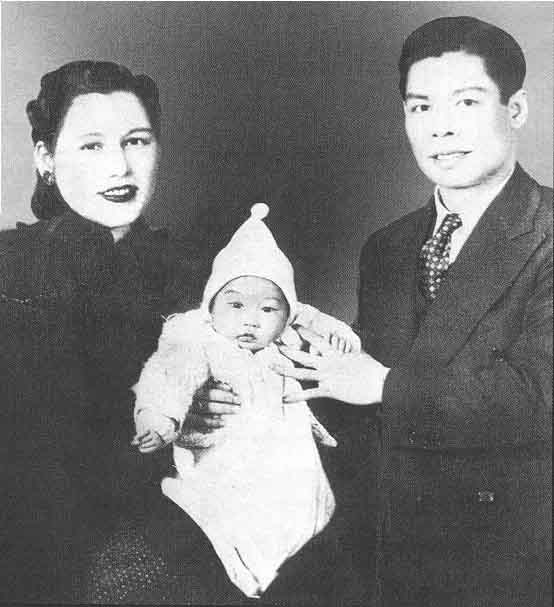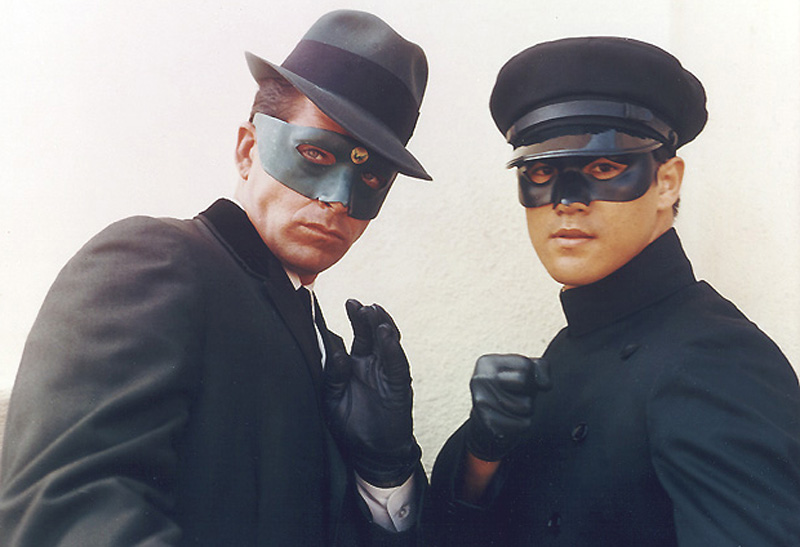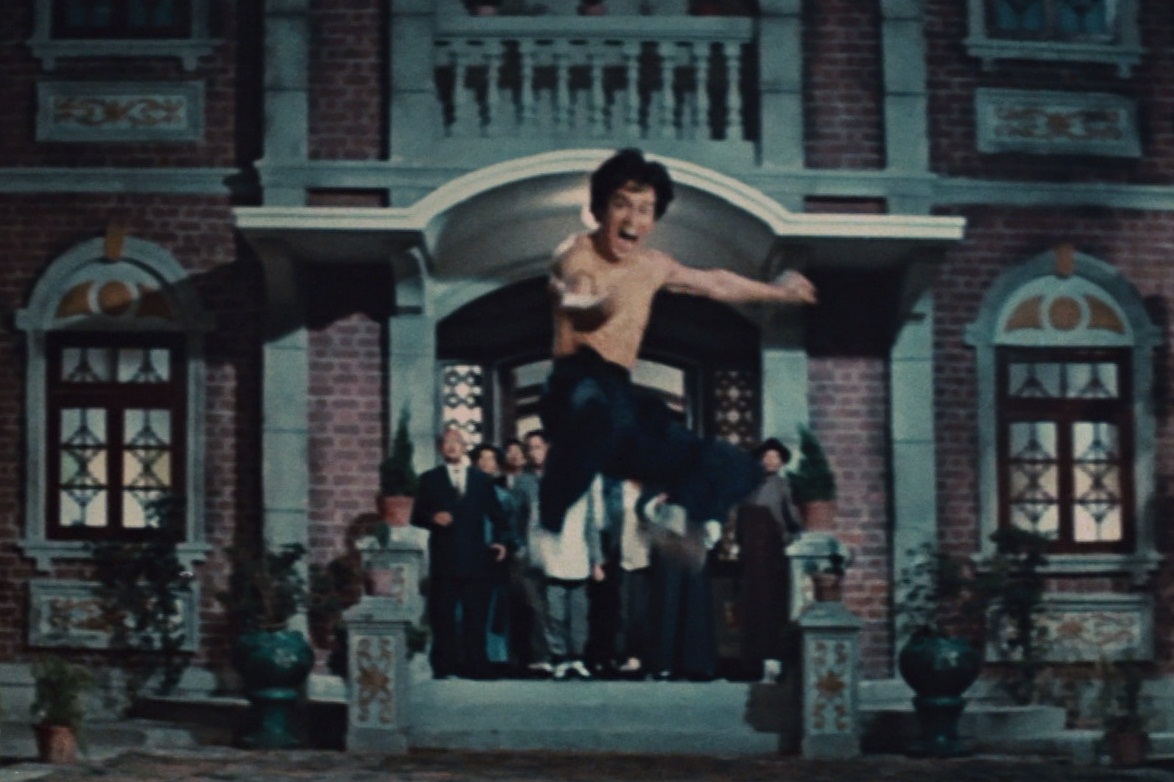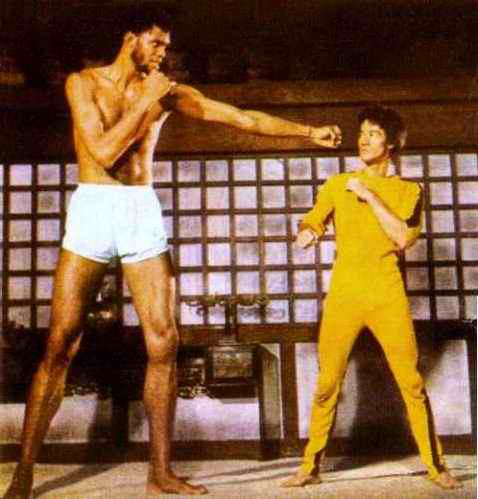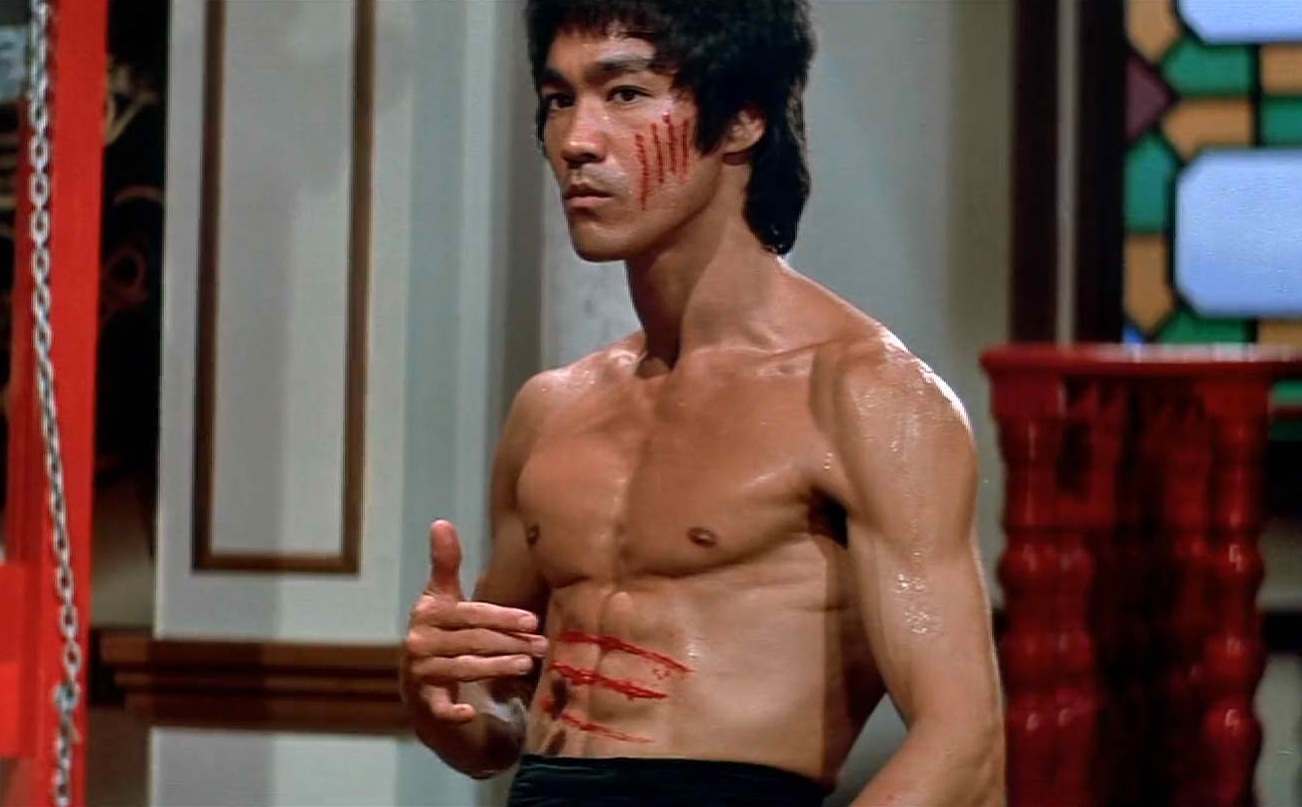
|
The Ninth Annual Dead Man of the Year Award...
By J.C. Maçek III 

Re-Enter the Dragon!
The 2013 Dead Man goes to the indestructible... It has been eight years now since WorldsGreatestCritic.com launched the first annual The Dead Man of the Year Award, honoring the great creature creator Willis H. O'Brien. Since then the awards have gone to many great artists who have left the world of entertainment a much better place while they were on this green Earth. We're talking about Superman Creators Jerry Siegel and Joe Shuster, Comedian Phil Hartman, special effects genius Stan Winston, actress and Trek pioneer Majel Barrett, DeadPAN of the year Leslie Nielsen, comics maestro Jack Kirby and visionary artist Ralph McQuarrie. That's quite a collection of past heroes to have been honored! As impressive as this list is (and, cousin, it is) the honoree of our ninth year could most assuredly kick every one of their asses effortlessly. Who am I talking about? This year's honoree was the one to die youngest of them all and was the third youngest overall (Hartman was eight years his junior and Winston was younger by six years). Even in their prime, however, it's hard to imagine any of these great honorees being in quite the shape the 2013 DMOTY was (making his young death even more tragic in a way). Who am I talking about? The great, great BRUCE LEE, of course, the man who brought the art of Kung Fu into the mainstream and re-defined what it meant to be an action hero and a leading man. As a Martial Arts instructor, he taught the likes of Roman Polanski, James Coburn, Lee Marvin, Chuck Norris, Joe Lewis, Kareem Abdul-Jabbar and many others. As an actor he teamed up with Batman and The Green Hornet, played the Game of Death, took down The Big Boss, introduced the world to The Way of the Dragon and showed fans the world over his Fists of Fury. That's not to mention his starring role in possibly the biggest martial arts film of all time, Enter the Dragon. However, the young man we know as Bruce Lee was already a veteran actor before any of these films and TV shows hit the screen. The young man known as Lee Jun-fan was actually a child actor in his native Hong Kong long before he graced American movie and TV screens. How long before? Lee first appeared in the motion picture Golden Gate Girl (1941), which was released when Lee was only six months old. Lee's father was an actor himself, a Cantonese Opera star named Lee Hoi-chuen who exposed his infant son to acting, theater and cinema literally from the time he was a baby (as Golden Gate Girl has documented). However, Lee was not born in Hong Kong. Hoi-Chuen and Lee's mother Grace Ho had young Jun-fan near the Golden Gate itself, while in San Francisco's Chinatown with the baby boy's three older siblings (a fifth child would later be born in Hong Kong). In addition to Jun-fan, other Chinese names Bruce would go by, include clan name Li Yuanxin, student name Li Yuanjian and stage name Li Xiaolong (which means "Little Dragon Lee"). Grace (who was half-Chinese and half-German) gave her son the name "Jun-fan" because the name is a homophone for the Cantonese words that translate to "return again". It was Grace's dream that young Jun-fan would, indeed, return again to California when he was old enough. She was right. Although young Lee would have to wait a whopping five years before starring in a film after Golden Gate Girl the kid managed to star in twenty films before his eighteenth birthday. Surprisingly, once 18 year old Bruce Lee did return again to California, it was not to pursue a film career, but to become a martial arts instructor and torunament competitor. During this time, Lee also enrolled in College himself, at the University of Washington where he studied drama, psychology and philosophy. At school, Lee also met a young lady named Linda Emery whom he married in 1964 (and together the two would have two children in Shannon Lee and the late, great Brandon Lee). However, Bruce, the student, soon found that he vastly preferred teaching to learning in the classroom, so he set out to open his own schools. Over the next several years Lee opened the school Jun Fan Gung Fu (or, "Bruce's Kung Fu", where he taught Wing Chun to his students) and the Jun Fan martial arts studio in Oakland, California. During this time Lee fought in several (often controversial) private matches and ultimately appeared in the Long Beach International Karate Championships in August of 1964. This was the most high-profile event that Lee had been involved with to date and it is no surprise that this tournament directly led to the resurrection of Lee's acting career. Film and television producer William Dozier approached Lee to audition for the TV Pilot Number One Son and the talented Bruce Lee delivered a mind-blowing screen test, demonstrating his martial arts skills on a stoic older gentleman without ever once touching him. Needless to say, however, if the "two for flinching" rule had been in place, this poor fellow would surely have received his fair share of punches. While Number One Son never aired, this screen test was not in vain, as, based on that short reel alone, Lee was invited to play Kato in the 1966-67 TV series The Green Hornet (along side one Van Williams in the title role) without any need for an audition. It was during the run of The Green Hornet that Lee also played Kato in three crossover episodes of TV's Batman, hopelessly outclassing that show's stars with his incredible martial arts skills. This high-profile role led to other impressive guest appearances on TV and another appearance at the 1967 Long Beach International Karate Championships (where he appeared both in and out of the character of Kato). While The Green Hornet lasted only one season, Lee was already a well-known instructor, actor and martial artist. His next steps were, again, not in the acting world, but back in the world of Martial Arts. One of the aforementioned controversial private matches Lee engaged in was a grudge match with the well known martial artist Wong Jack Man. This 1964 fight has as many varied accounts as Lee's skin would have scratches during the climax of Enter the Dragon. Lee claimed that the fight was the direct result of Lee's nondescrimination against non-Chinese students in his schools, while Wong claimed that he, himself had no such prejudices and the fight was requested due to an open challenge issued by Lee. Some claim that the fight lasted an incredibly long time clocking in at almost a full half-hour, while others claim that Lee's decisive victory was almost immediate at three minutes. What we do know is that Lee continued to teach Caucasians, African Americans and other non-Chinese his arts of Gung Fu. It is also said that this match led directly to Lee's next philosophy of Martial Arts, which he employed at his new school after the completion of The Green Hornet. This new eclectic and iconoclastic system is known as Jeet Kune Do (also Jeet Kun Do) and is often abbreviated to JKD. This Martial Arts style was described by Lee as "style without style", "the art of expressing the human body" and "the art of fighting without fighting" (see the aforementioned "two for flinching" reference above). This style, in part, revolved around interpreting an opponent's actions before they are made. Watching Lee in action, one can imagine just what that entailed. This art also eschewed the rigid, formalized approach to Martial Arts and promised to shorten fights with virtually any more formal apponent. JKD soon became known as "The Way of the Intercepting Fist". More acting roles followed for Lee due, in part, to the fact that so many of his students were famous actors, directors and screenwriters. During this time, Lee also worked with Paramount and Warner Bros. on a modernized idea for a Western television show that would presumably star Lee. The Warrior as it was then-called was doubted by Lee to even be made, considering the fact that in the late 1960s and early 1970s there were very few non-white leading men on Television. However, the TV series apparently was made, not as The Warrior but as Kung Fu (1972) and without Lee as the leading man, but with then-non martial artist (and caucasian) David Carradine as the main character Caine (re-written as a half-Chinese, half white Shaolin monk). Around this same time, Lee, Coburn and writer Stirling Silliphant (another Lee student) were working on a new film called The Silent Flute and the project went as far as the location scouting phase before being abandoned. The plot of this film was eventually made into the movie Circle of Iron. That 1978 film also starred... David Carradine. One must wonder how Kill Bill might have looked had Bruce Lee survived. Still, Lee was hardly without roles and over the next few years he worked with such stars as James Garner, Chuck Norris, Dean Martin, James Franciscus, Anthony Quinn, Ingrid Bergman and even Sharon Tate. One might have believed that Lee had it made at this point, however, he was unhappy with his progress, Lee took a friend's advice and moved back to Hong Kong with the intention of creating a film that would showcase his skills to Hollywood and, thus, lead to bigger roles. Lee was surprised to discover that his fame preceded him to Hong Kong, and not just from his years as a child actor. Lee was immediately recognized as Kato on the streets of Hong Kong and Green Hornet fans there were elated to have back the star of what they often called "The Kato Show". Lee contracted with production company Golden Harvest to produce two films, starting with The Big Boss (1971). Lee's first Hong Kong film in almost two decades broke box office records throughout Asia and catapulted the 31 year old actor to international superstardom. If he had stopped there, he would still have become a legend, but the second film, Fist of Fury broke the box office records previously set by The Big Boss. The Big Boss was a 1971 action film about the international drug trade which reminded many audiences of the contemporary film The French Connection, hence The Big Boss’ intended US release title of “The Chinese Connection”. The operative word, in this case, is “intended” as The Big Boss was released internationally as Fists of Fury, while Lee’s next film, the non-pluralized Fist of Fury hit US screens as The Chinese Connection due to an accident of title-switching. From Boss to Connection and from Fist to Fists... two for flinching. Both films were directed by Lo Wei and produced by Raymond Chow, but even contemporary commentators believed that much of the fight choreography (and even directing) was surely done by Bruce Lee himself. One indesputable fact is that the second film Bruce starred in within the year of 1972 was entirely written and directed by Bruce Lee himself. Way of the Dragon was retitled Return of the Dragon for its US release (where it was often advertised as a sequel to Enter the Dragon). The martial arts in Way/ Return are stunning. Here, Lee defies gravity, moves impossibly fast and twists his body into shockingly improbable contortions, like a one-man Justice League. One could find all kinds of high-minded reasons to enjoy Way of the Dragon, but let’s face facts… the reason to watch this movie is Bruce Lee’s final battle with none other than Chuck Norris… at the Roman Coliseum. This climactic battle between Norris and Lee requires seatbelts and has a height restriction in order to ride. Children and pregnant women should not take this ride without consulting a physician first. Safety goggles and crash helmets are recommended for this mother of all fight scenes and professional athletes should take special care before looking directly at this battle for fear of accidentally testing positive for testosterone boosting. There may be no filmic melee more deserving of the word “awesome” that does not actually include light sabers. Did I happen to mention that the finalé of Way of the Dragon features Chuck Norris in battle with Bruce Lee at the Roman Coliseum? Because, if I failed to mention this… Chuck Norris vs. Bruce Lee!!!!! After Way of the Dragon, Lee went on to begin his most ambitious project yet. Game of Death, intended to be the biggest worldwide demonstration of Lee’s martial arts style-of-no-style “Jeet Kune Do” (“Way of the Intercepting Fist”). After 100 minutes of footage was directed by Lee, Warner Bros. invited Lee to star in their new Martial Arts epic, to be entitled Enter the Dragon. Clearly, Lee was hardly still sore about the transformation of The Warrior into Kung Fu (which had begun airing in October of 1972) because Lee readily agreed to the film which would become the biggest Kung Fu film of all time and a model for many movies as time has gone on. Sadly, one person who would not see the international success of Enter the Dragon was the star himself. Lee was heavily involved in the production of this film, even directing certain scenes. Sadly, during the post-production of Enter the Dragon Bruce Lee died of an apparent cerebral edema (possibly exacerbated by pain medications) and the world was shocked by his untimely demise and the fact that he lost his life right at the cusp of his superstardom in Hollywood. Bruce Lee's last day on Earth was July 20, 1973. He was only 32 years of age. Enter the Dragon was released in his native Hong Kong six days after his death and in the United States on August 17 of the same year. Enter the Dragon was an incredible success earning $115 million worldwide in its opening run on a budget of only $850,000. The film was very well received by critics and was hailed as one of the best movies of 1973. Enter the Dragon has also gone on to be preserved as "culturally significant" by the Library of Congress and has been importalized in the National Film Registry. Thus, the career of Bruce Lee was over, leaving his legacy. This, of course, meant that Game of Death was never completed by Lee. Lee was working from an incomplete screenplay for Game of Death at the time he lost his own life in the real game. Sadly, his true, original vision was never to be seen. Instead, much of Lee’s footage (albeit out-of-order) was incorporated into a new film (also entitled Game of Death), written by Jan Spears, produced by Raymond Chow and directed by Enter the Dragon’s Robert Clouse. Lee's fight footage is astounding and his yellow and black jumpsuit and matching sneakers have become legendary. But instead of being a level-by-level battle through martial artists in a five-story pagoda (as Lee originally intended) the new Game of Death (released in 1978, five years after Lee’s death) focuses on “Billy Lo”, an obvious Pastiche of Bruce Lee. Lo is a martial arts movie star who dies in the making of one of his films. The twist is that Lo, unlike Lee, doesn’t die, but undergoes reconstructive surgery in order to take revenge on the foreign criminals who attempted to take him out. Hence martial artists Kim Tai-jong and Yuen Biao are able to (quite unconvincingly) double for Lee for three-fourths of the film. The MacGuffin of Lo’s reconstructive surgery allowing for the new face(s) also fails to make sense as the real Bruce Lee is seen toward the beginning of the film (in outtakes and actual footage from Fist of Fury and Way of the Dragon), then is replaced by his stand-ins for the bulk of the feature and then the real Lee is back for the actual Game of Death fight scenes he had already filmed. So the "new" Game of Death would have us believe that "Billy Lo" looked exactly like Bruce Lee until he was shot in the face, then underwent plastic surgery to look like two other guys (aided by big sunglasses and a fake beard) and ultimately reverted to looking exactly like Bruce Lee again. What, was this plastic surgery on a timer made by the witch from Cinderella? "After midnight the carriage turns back into a pumpkin, the horses turn back into mice, your dress turns back into rags... oh, and Billy Lo turns back into Bruce Lee." I hope you kept the receipt, because I'm not buying that and kids, the one thing that Game of Death does make perfectly clear is that there is only ONE BRUCE LEE! Of course, that isn't what worldwide studios would want you to believe. From 1973 forward every chance to cash in on Bruce Lee's success was taken. This included re-releasing his films with new names and also creating many phony films packaged as sequels or sister films to Lee's. These included such films as Game of Death II, New Fist of Fury, Re-Enter the Dragon, Enter Two Dragons, Return of Bruce, Enter Another Dragon, Return of the Fists of Fury and Enter the Game of Death... not kidding. More films like Exit the Dragon, Enter the Tiger, Fist of Vengeance and the comedic films They Call Me Bruce? and Enter the Fat Dragon followed. Bruceploitation reached a ridiculous peak with such films as The Clones of Bruce Lee and The Dragon Lives Again (in which Lee goes to hell to do battle with both Dracula and James Bond). Worst of all were the many Bruce Lee imitators out there. Sure there were legitimate stars and stars-to-be such as Sammo Hung and Jackie Chan who were sometimes advertised as "The Next Bruce Lee", however there were also the stars of many "exploitation" flicks that intended to fool audiences into believing they were seeing a new Bruce Lee film. These "stars" included Bruce Li, Bruce Le and Dragon Lee. Thankfully, Exploitation Crazes died down and more serious tributes to Lee began to arise in the coming years. mostly in the form of documentaries and the adoption of Bruce's martial arts styles. Bruce's son Brandon began to receive notice due to his acting, good looks and great martial arts skills. Sadly, the younger Lee died during the filming of The Crow in 1993 (giving eerie rise to rumors of a Lee family Curse). Thus a legitimate dramatic film based on the life of Bruce Lee was dedicated to both Bruce and Brandon. This 1993 film was known as Dragon: The Bruce Lee Story, starring Jason Scott Lee, and was a critical and box office success. The year of 2013 marked the 40th anniversary of Bruce Lee's death and Bruce Lee's legacy is bigger than ever. Lee's students have gone on to teach more students the ways of the Dragon, including and especially his three personally certified instructors Taky Kimura, James Yimm Lee, and Dan Inosanto. These instructors have certified others and the arts of Jeet June Do and Jun Fan Gung Fu continue to gain in popularity. Bruce Lee is still seen in television commercials and in print advertisements to this day. 2013 also marked the anniversary of Bruce's passing with re-releases of the films he starred in. Shout! Factory released teh 11-disc The Bruce Lee Legacy Collection containing Game of Death, Way of the Dragon, Fist of Fury and The Big Boss along with a tresure trove of Extras and Warner Bros. released the Enter the Dragon: 40th Anniversary Edition Blu-Ray, also with a boat load of extras. In addition, The Kentucky Fried Movie, which features a long spoof of Enter the Dragon in the form of "A Fistful of Yen" was also re-released in 2013 with yet another admirable collection of extras. Yes, I did review all three for That Other Magazine I work for. Bruce was survived by his students as well as Linda and Shannon. Brandon is still remembered and honored for his acting and fighting. Linda Lee Caldwell is a writer and teacher who is still active today and continues to run The Bruce Lee Foundation (with her son-in-law Ian Keasler) while Shannon Lee is an actress and businesswoman who is known for running Bruce Lee's official Facebook page. Bruce Lee remains perhaps the biggest name in all of martial arts and one of the biggest names in action films not because of, but in spite of his untimely death. Had he lived, there is no telling what magic he could have brought to the screen. Until Bruce Lee, starring roles in American films for Non-whites were very rare, but Bruce Lee was among the pioneers who showed the world that talent comes before Race. Lee was a fantastic Martial Artist as well as a phenominal actor, director, writer and visionary. See you in the next reel, little dragon, fighting man, teacher and artist who taught us how to fight without fighting! Rest in Peace, God Bless, and may you Return Again!
Bruce Lee
|
Scream your best martial cry and CLICK HERE for MORE REVIEWS The 2013 World's Greatest Critic's Dead Man of the Year Awarded to Bruce Lee! This article was written and researched by J.C. Maçek III who is solely responsible for the content of all of this website Including the final decision of unparalleled awardee year after year. Nominate yours for 2014 now, or face the FISTS! Got something to say? Write it!
| |


